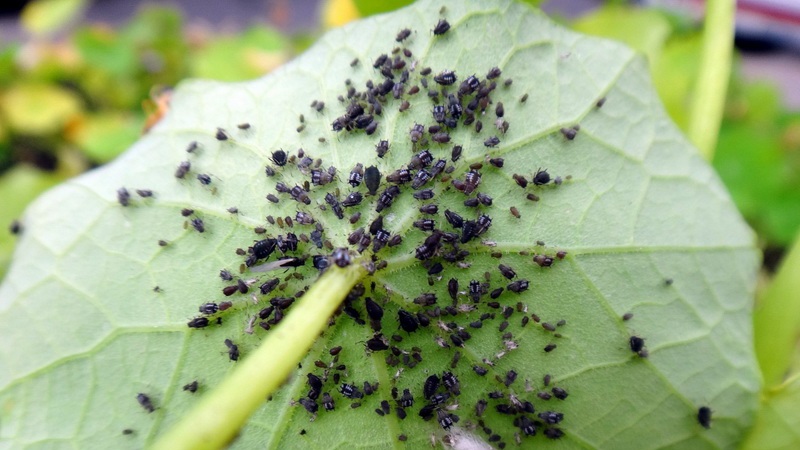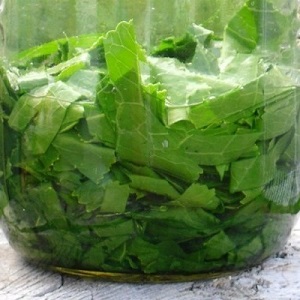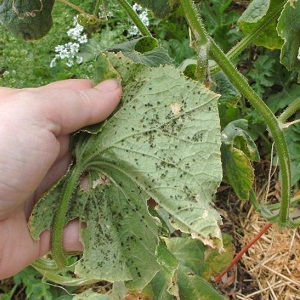Why is black aphid on cucumbers dangerous and how to deal with the pest as efficiently as possible
Black aphids on cucumbers are one of the most dangerous pests that gardeners face. Small bugs multiply at lightning speed and infect leaves. In this article, we will talk about the danger posed by insects, signs of infection and effective methods of dealing with folk remedies, insecticides and biological preparations.
The content of the article
Why aphids are dangerous for cucumbers
Aphids are a pest that reproduces at an incredible rate... It affects all plants, except for needles. Most often found on climbing plants. There are more than 4000 species of these insects in the world.

Cucumbers are also often affected by black aphids.... If you do not take urgent measures after the detection of the pest, you can be left without a crop.
What does it look like
Black aphids are small black bugs, 2-5 mm long... Adapts to any weather conditions. He spends winter in the state of eggs, so processing during this period is considered as effective as possible. During the summer period, the female reproduces more than 10 times (50 eggs in one clutch).
Dangerous for cucumbers during the period when it can fly... This is due to the fact that insects live in colonies and multiply rapidly. In search of food, bugs fly to neighboring plants. Colonies accumulate on the upper leaves and never settle on the lower ones, since bugs cannot bite through the dense tissues of the plant. Therefore, surface treatment is sufficient to destroy the pest.
Biologists are of the opinion that aphids are brought into the site her faithful companions are ants. Insects feed on honeydew, the sweet liquid secreted by aphids.
The bugs suck the juice from the leaves and cover them with a sticky coating. it leads to disruption of the process of photosynthesis and the addition of a bacterial infection.
Symptoms of the defeat of cucumbers
Such signs will help to recognize the presence of aphids on cucumbers.:
- slowdown in growth and flowering;
- twisted, drooping and dry top leaves;
- areas covered with honeydew;
- ants scurrying around the plant;
- shedding of the ovaries;
- wilting of the lower leaves;
- many small black bugs on the back of the leaves.

How to deal with a pest
Gardeners spend a lot of effort on fighting the pest, especially when the number of insects is off scale. For this use homemade folk remedies, chemical and biological preparations.
Manual collection is a rather laborious method of getting rid of aphids, and is suitable in cases of minimal damage. After removing the insects, the bushes are watered with boiling water.
About other pests of cucumbers:
How to get rid of whitefly in a greenhouse on cucumbers
Traditional methods
Folk remedies are used when the ovary appears... It is not recommended to use chemical preparations during this period, since the substances are actively absorbed by the rhizome and fruits. You will have to get rid of such a crop.
Experienced gardeners advise use such folk remedies:
- Infusion of tobacco. Take 400 g of shag and pour 10 liters of boiling water. Cover the bucket with a lid and leave to infuse for 48 hours. Add small shavings of laundry soap and stir before use. Use the infusion to irrigate the bushes.
 Horseradish infusion. Take 8-10 roots, chop and pour 3 liters of boiling water. Pass through the filter after 3 hours.Fill the cake with 3 liters of distilled warm water, after three hours combine both concentrates. Before use, mix 200 ml of infusion with 5 liters of water and spray the plants.
Horseradish infusion. Take 8-10 roots, chop and pour 3 liters of boiling water. Pass through the filter after 3 hours.Fill the cake with 3 liters of distilled warm water, after three hours combine both concentrates. Before use, mix 200 ml of infusion with 5 liters of water and spray the plants.- Garlic. Take 250 g of garlic, chop and pour 1 liter of clean water. Close the container with a lid and leave for five days. Irrigate the bushes with the resulting solution.
- Hot pepper. Finely chop 3 pepper pods and add to 10 liters of water. Place the bucket in a warm room for 24 hours, then pass the liquid through cheesecloth and stir in 60 ml of liquid soap, 150 g of ash, 3 drops of iodine. Pour the solution into a container with a spray bottle and process the bushes.
- Mustard. Take 10 g of mustard beans and pour 1 liter of water. After two days, add 800 ml of settled water and process the bushes.
- Celandine. Take 300 g of dry herb and pour 10 liters of water. Leave the container in a warm place for two days. Spray the bushes.
- Dandelion. Finely chop 400 g roots and 600 g fresh leaves. Pour 10 liters of water. After three hours, start watering the plants.
- Yarrow. Take 900 g of grass and pour 2 liters of hot water. Leave for an hour to infuse. Before using the concentrated product, dilute with 10 liters of water. For 1 m² you will need 1 liter of solution.
- Wood ash. Take 60 g of ash and 100 g of laundry soap crumbs. Pour in 10 liters of water and stir. Add 5 drops of tea tree essential oil.
- Soap solution. Dissolve 125 ml of liquid tar soap in 10 liters of warm water. Use a solution to water the bushes.
- Onion peel. Take 40 g of raw materials soak in 3 liters of warm water overnight. Add 5 ml of liquid soap and stir.
- Soda. For 2 liters of settled water, take 60 g of baking soda and 18 drops of lavender and cedar essential oil. Water the bushes three times a day until the aphids disappear completely.
- Milk serum. Use undiluted on bushes.
- Table vinegar. Take 1 tsp. vinegar 9% per 1 liter of water and irrigate with the plant solution.
Chemicals
Chemicals will come to the rescue if it was not possible to stop the reproduction of insects by folk methods. The most effective insecticides include:
- "Decis" is an insecticide of contact action, it starts working one hour after treatment.
- Inta-Vir is available in the form of powder and tablets for dilution in water. Kills aphids and whiteflies quickly.
- "Aktara" is a long-acting drug that starts working two hours after irrigation.
- Tanrek is a systemic drug. Processing is carried out every three weeks.
- "Danadim" is a low-toxic insecticide that gets rid of pests in 48 hours.
- "Confidor" - begins to work three days after irrigation of plants.
Reference. The manufacturer places the instructions for use with the dosage and frequency of processing on the package.
Biological preparations
These funds are the result of microbiological synthesis with a more aggressive effect., despite the prefix "bio", but completely harmless to humans:
 "Bitoxibacillin" contains special bacteria that attack insects and does not harm the environment.
"Bitoxibacillin" contains special bacteria that attack insects and does not harm the environment.- Aquarin kills aphids in 48 hours. During the season, the product is used no more than three times.
- "Aktofit" affects the nervous system of insects, eliminates pests in 48 hours.
- Fitoverm kills pests in three days. Cucumbers can be eaten three days after processing the bushes.
- "Entobacterin" completely eliminates insects in a week.
- "Strela" is a drug with bitoxibacillin as an active ingredient. Completely eliminates the pest in 10 days.
Features of insect control in the greenhouse
To get rid of aphids when growing cucumbers in a greenhouse use insecticides, biologicals and folk remedies. During irrigation with chemicals, respiratory protection is used, since in an enclosed space you can get serious poisoning.
Additionally use potassium-phosphorus fertilizing... In 10 liters of water add 10 g of potassium sulfate and 20 g of superphosphate.The resulting mixture is irrigated with bushes 1 time in 10 days. Strong plants are affected by aphids less frequently than weak ones.
The topsoil is removed in autumn or treated with insecticides, if this is not possible. When the air temperature in the greenhouse drops to +10 ° C, the room is treated with a sulfur stick. The smoke destroys aphid larvae and bacteria.
It can be useful:
Outdoors
 When growing cucumbers in the open air, use the same meansas for the processing of greenhouse plants. As an additional method, mustard leaves, odorous dill are planted on the site, which attract ladybugs - faithful helpers in the fight against aphids.
When growing cucumbers in the open air, use the same meansas for the processing of greenhouse plants. As an additional method, mustard leaves, odorous dill are planted on the site, which attract ladybugs - faithful helpers in the fight against aphids.
Digging the land on the site, remove weeds along with roots, old rotten stumps and anthills, in which black aphids like to winter. To scare away ants, use the "Anteater" agent or fill the anthill with hot water.
There is a more humane way - the constant loosening of the soil helps to drive away insects that do not like interference in their life.
Council. Plant marigolds, oregano, daisies, anise, and cumin next to cucumbers to attract beneficial insects.
Preventive measures
To prevent contamination of cucumbersexperienced farmers recommend:
- choose varieties that are resistant to insects;
- tighten ventilation openings in greenhouses and hotbeds with gauze or fine mesh;
- cover bushes in open beds with a thin cloth;
- in parallel, fight ants;
- carry out frequent weeding of weeds;
- disinfect seeds before sowing;
- treat the soil and the greenhouse with disinfecting compounds (potassium permanganate, copper sulfate);
- use sulfur checkers for disinfection in the fall;
- change spray preparations periodically to prevent addiction;
- do not plant seedlings too tightly;
- regularly apply mineral and organic fertilizing.

Summer residents advice
Experienced gardeners and farmers share tips for effective control of black aphids on cucumbers:
- Inspect the bushes regularly, especially the leaves on the back. At the slightest sign of damage, start irrigating the plants with folk remedies.
- If homemade infusions and solutions do not work, switch to chemical and biological agents.
- Feed your cucumbers regularly with a potassium-phosphorus mixture.
- At the same time, wage a "war" with ants, otherwise the aphids will return again and again.
- Weed the beds from time to time.
- Remove the affected plant parts and incinerate immediately.
- Rinse the bushes with a hose before flowering.
Conclusion
Black aphids on cucumbers are a dangerous pest that can cause irreparable damage to the plant and significantly reduce yields. Modern drugs of chemical and biological nature ("Arrow", "Aquarin", "Confidor", "Fitoverm", etc.) help to quickly and effectively get rid of the problem.
An integrated approach using folk remedies (soap solution, infusion of wood ash, herbs, garlic), preventive measures and the attraction of beneficial insects will help to secure the harvest.